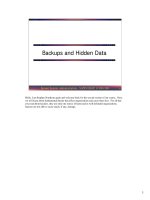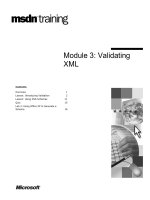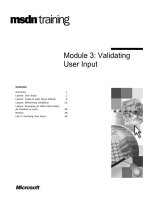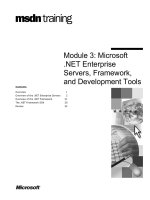Tài liệu Module 3: Retrieving Data doc
Bạn đang xem bản rút gọn của tài liệu. Xem và tải ngay bản đầy đủ của tài liệu tại đây (1.03 MB, 50 trang )
Contents
Overview 1
Retrieving Data by Using the
SELECT Statement 2
Filtering Data 8
Formatting Result Sets 20
How Queries Are Processed 28
How Queries Are Cached Automatically 29
Performance Considerations 31
Recommended Practices 32
Lab A: Retrieving Data and Manipulating
Result Sets 33
Review 45
Module 3:
Retrieving Data
Information in this document is subject to change without notice. The names of companies,
products, people, characters, and/or data mentioned herein are fictitious and are in no way intended
to represent any real individual, company, product, or event, unless otherwise noted. Complying
with all applicable copyright laws is the responsibility of the user. No part of this document may
be reproduced or transmitted in any form or by any means, electronic or mechanical, for any
purpose, without the express written permission of Microsoft Corporation. If, however, your only
means of access is electronic, permission to print one copy is hereby granted.
Microsoft may have patents, patent applications, trademarks, copyrights, or other intellectual
property rights covering subject matter in this document. Except as expressly provided in any
written license agreement from Microsoft, the furnishing of this document does not give you any
license to these patents, trademarks, copyrights, or other intellectual property.
2000 Microsoft Corporation. All rights reserved.
Microsoft, BackOffice, MS-DOS, PowerPoint, Visual Studio, Windows, Windows Media, and
Windows NT are either registered trademarks or trademarks of Microsoft Corporation in the
U.S.A. and/or other countries.
The names of companies, products, people, characters, and/or data mentioned herein are fictitious
and are in no way intended to represent any real individual, company, product, or event, unless
otherwise noted.
Other product and company names mentioned herein may be the trademarks of their respective
owners.
Project Lead: Cheryl Hoople
Instructional Designer: Cheryl Hoople
Technical Lead: LeRoy Tuttle
Program Manager: LeRoy Tuttle
Graphic Artist: Kimberly Jackson (Independent Contractor)
Editing Manager: Lynette Skinner
Editor: Wendy Cleary
Editorial Contributor: Elizabeth Reese
Copy Editor: Bill Jones (S&T Consulting)
Production Manager: Miracle Davis
Production Coordinator: Jenny Boe
Production Tools Specialist: Julie Challenger
Production Support: Lori Walker (S&T Consulting)
Test Manager: Sid Benavente
Courseware Testing: Testing Testing 123
Classroom Automation: Lorrin Smith-Bates
Creative Director, Media/Sim Services: David Mahlmann
Web Development Lead: Lisa Pease
CD Build Specialist: Julie Challenger
Online Support: David Myka (S&T Consulting)
Localization Manager: Rick Terek
Operations Coordinator: John Williams
Manufacturing Support: Laura King; Kathy Hershey
Lead Product Manager, Release Management: Bo Galford
Lead Product Manager: Margo Crandall
Group Manager, Courseware Infrastructure: David Bramble
Group Product Manager, Content Development: Dean Murray
General Manager: Robert Stewart
Module 3: Retrieving Data iii
Instructor Notes
This module provides students with the knowledge and skills to perform basic
queries by using the SELECT statement, which includes sorting data,
eliminating duplicates, and changing the format of the result set. The module
concludes with a description of how queries are processed.
At the end of this module, students will be able to:
!
Retrieve data from tables by using the SELECT statement.
!
Filter data by using different search conditions to use with the WHERE
clause.
!
Format result sets.
!
Describe how queries are processed.
!
Describe performance considerations that affect retrieving data.
Materials and Preparation
Required Materials
To teach this module, you need the following materials:
!
Microsoft
®
PowerPoint
®
file 2017A_03.ppt.
!
The C:\MOC\2071A\Demo\Ex_03.sql example file, which contains all of
the example scripts from the module, unless otherwise noted in the module.
Preparation Tasks
To prepare for this module, you should:
!
Read all of the materials.
!
Complete all demonstrations.
!
Complete the labs.
Presentation:
45 Minutes
Labs:
45 Minutes
iv Module 3: Retrieving Data
Module Strategy
Use the following strategy to present this module:
!
Retrieving Data by Using the SELECT Statement
Explain how to retrieve specific columns and rows by using the SELECT
statement and the WHERE clause.
!
Filtering Data
Describe how to restrict the number of rows that are returned by using
search conditions in the WHERE clause. Discuss comparison and logical
operators, character strings, range of values, list of values, and unknown
values.
!
Formatting Result Sets
Describe how to format the result set to improve readability by sorting data,
eliminating duplicate data, changing column names to aliases, and using
literals. Explain that these formatting options do not change the data, only
the presentation of it.
!
How Queries Are Processed
Describe how queries are processed. Mention that all queries follow the
same process before they execute and that Microsoft SQL Server
™
2000 can
store some of the processing for subsequent execution of the same query.
Then briefly describe the benefits of cached queries and the ways in which
queries can be cached.
!
Performance Considerations
Discuss some of the issues that affect the performance of SQL Server when
you perform basic queries.
Customization Information
This section identifies the lab setup requirements for a module and the
configuration changes that occur on student computers during the labs. This
information is provided to assist you in replicating or customizing Microsoft
Official Curriculum (MOC) courseware.
The lab in this module is dependent on the classroom configuration
that is specified in the Customization Information section at the end of the
Classroom Setup Guide for course 2071A, Querying Microsoft SQL Server
2000 with Transact-SQL.
Lab Setup
There are no lab setup requirements that affect replication or customization.
Lab Results
There are no configuration changes on student computers that affect replication
or customization.
Importan
t
Module 3: Retrieving Data 1
Overview
!
Retrieving Data by Using the SELECT Statement
!
Filtering Data
!
Formatting Result Sets
!
How Queries Are Processed
!
Performance Considerations
This module provides students with the knowledge and skills to perform basic
queries by using the SELECT statement, which includes sorting data,
eliminating duplicates, and changing the format of the result set. The module
concludes with a description of how queries are processed.
At the end of this module, students will be able to:
!
Retrieve data from tables by using the SELECT statement.
!
Filter data by using different search conditions to use with the WHERE
clause.
!
Format results sets.
!
Describe how queries are processed.
!
Describe performance considerations that affect retrieving data.
Slide Objective
To provide an overview of
the module topics and
objectives.
Lead-in
In this module, you will learn
how to retrieve data by
using basic queries.
2 Module 3: Retrieving Data
#
##
#
Retrieving Data by Using the SELECT Statement
!
Using the SELECT Statement
!
Specifying Columns
!
Using the WHERE Clause to Specify Rows
Before you can work with data, you must select the data that you want to
retrieve from your tables. You can use the SELECT statement to specify the
columns and rows of data that you want to retrieve from tables.
Slide Objective
To list the topics that the
following sections covers.
Lead-in
Retrieving data from tables
includes using the SELECT
statement, which involves
specifying columns
and rows.
Module 3: Retrieving Data 3
Using the SELECT Statement
SELECT [ALL | DISTINCT] <select_list>
FROM {<table_source>} [,…n]
WHERE <search_condition>
SELECT [ALL | DISTINCT] <select_list>
FROM {<table_source>} [,…n]
WHERE <search_condition>
Partial Syntax
!
Select List Specifies the Columns
!
WHERE Clause Specifies the Rows
!
FROM Clause Specifies the Table
Use the SELECT statement to retrieve data.
SELECT [ ALL | DISTINCT ] <select_list>
FROM {<table_source>} [,...n]
[ WHERE <search_condition> ]
Use the SELECT statement to specify the columns and rows that you want to be
returned from a table:
!
The select list specifies the columns to be returned.
!
The WHERE clause specifies the rows to return. When you use search
conditions in the WHERE clause, you can restrict the number of rows by
using comparison operators, character strings, and logical operators as
search conditions.
!
The FROM clause specifies the table from which columns and rows
are returned.
Slide Objective
To discuss using the
SELECT statement to
retrieve data from a table.
Lead-in
Use the SELECT statement
to retrieve data.
Partial Syntax
4 Module 3: Retrieving Data
Specifying Columns
employeeid
employeeid
employeeid
lastname
lastname
lastname
firstname
firstname
firstname
title
title
title
1
1
Davolio
Davolio
Nancy
Nancy
Sales Representative
Sales Representative
2
2
Fuller
Fuller
Andrew
Andrew
Vice President, Sales
Vice President, Sales
3
3
Leverling
Leverling
Janet
Janet
Sales Representative
Sales Representative
4
4
Peacock
Peacock
Margaret
Margaret
Sales Representative
Sales Representative
5
5
Buchanan
Buchanan
Steven
Steven
Sales Manager
Sales Manager
6
6
Suyama
Suyama
Michael
Michael
Sales Representative
Sales Representative
7
7
King
King
Robert
Robert
Sales Representative
Sales Representative
8
8
Callahan
Callahan
Laura
Laura
Inside Sales Coordinator
Inside Sales Coordinator
9
9
Dodsworth
Dodsworth
Anne
Anne
Sales Representative
Sales Representative
USE northwind
SELECT employeeid, lastname, firstname, title
FROM employees
GO
USE northwind
SELECT employeeid, lastname, firstname, title
FROM employees
GO
You can retrieve particular columns from a table by listing them in the
select list.
The select list contains the columns, expressions, or keywords to select or the
local variable to assign. The options that can be used in the select list include:
<select_list> ::=
{ *
| { table_name | view_name | table_alias }.*
| { column_name | expression | IDENTITYCOL | ROWGUIDCOL }
[ [AS] column_alias ]
| column_alias = expression
} [,...n]
When you specify columns to retrieve, consider the following facts
and guidelines:
!
The select list retrieves and displays the columns in the specified order.
!
Separate the column names with commas, except for the last column name.
!
Avoid or minimize the use of an asterisk (*) in the select list. An asterisk is
used to retrieve all columns from a table.
Slide Objective
To show how to select
columns within a table.
Lead-in
You can retrieve particular
columns from a table by
listing them in the select list.
Partial Syntax
Module 3: Retrieving Data 5
This example retrieves the employeeid, lastname, firstname, and title columns
of all employees from the employees table.
USE northwind
SELECT employeeid, lastname, firstname, title
FROM employees
GO
employeeid lastname firstname title
1 Davolio Nancy Sales Representative
2 Fuller Andrew Vice President, Sales
3 Leverling Janet Sales Representative
4 Peacock Margaret Sales Representative
5 Buchanan Steven Sales Manager
6 Suyama Michael Sales Representative
7 King Robert Sales Representative
8 Callahan Laura Inside Sales Coordinator
9 Dodsworth Anne Sales Representative
(9 row(s) affected)
Example
Result
6 Module 3: Retrieving Data
Using the WHERE Clause to Specify Rows
employeeid
employeeid
employeeid
lastname
lastname
lastname
firstname
firstname
firstname
title
title
title
5
5
Buchanan
Buchanan
Steven
Steven
Sales Manager
Sales Manager
USE northwind
SELECT employeeid, lastname, firstname, title
FROM employees
WHERE employeeid = 5
GO
USE northwind
SELECT employeeid, lastname, firstname, title
FROM employees
WHERE employeeid = 5
GO
Using the WHERE clause, you can retrieve specific rows based on given search
conditions. The search conditions in the WHERE clause can contain an
unlimited list of predicates.
<search_condition> ::=
{ [ NOT ] <predicate> | ( <search_condition> ) }
[ {AND | OR} [NOT] {<predicate> | ( <search_condition> ) } ]
} [,...n]
The predicate placeholder lists the expressions that can be included in the
WHERE clause. The options that can be contained in a predicate include:
<predicate> ::=
{
expression { = | <> | > | >= | < | <= } expression
| string_expression [NOT] LIKE string_expression
[ESCAPE 'escape_character']
| expression [NOT] BETWEEN expression AND expression
| expression IS [NOT] NULL
| CONTAINS
( {column | * }, '<contains_search_condition>' )
| FREETEXT ( {column | * }, 'freetext_string' )
| expression [NOT] IN (subquery | expression [,...n])
| expression { = | <> | > | >= | < | <= }
{ALL | SOME | ANY} (subquery)
| EXISTS (subquery)
}
Slide Objective
To introduce how to
retrieve rows by using the
WHERE clause.
Lead-in
Using the WHERE clause,
you can retrieve specific
rows based on given
search conditions.
Delivery Tip
Compare the result set from
the previous slide to the one
in this slide.
Point out that using the
WHERE clause restricts
the number of rows that
are returned.
The syntax that is listed
here is found in the “Search
Condition (T-SQL)” topic in
SQL Server Books Online,
not in the “SELECT
statement” topic.
Module 3: Retrieving Data 7
When you specify rows with the WHERE clause, consider the following facts
and guidelines:
!
Place single quotation marks around all char, nchar, varchar, nvarchar,
text, datetime, and smalldatetime data.
!
Use a WHERE clause to limit the number of rows that are returned when
you use the SELECT statement.
This example retrieves the employeeid, lastname, firstname, and title columns
from the employees table for the employee with an employeeid of 5.
USE northwind
SELECT employeeid, lastname, firstname, title
FROM employees
WHERE employeeid = 5
GO
employeeid lastname firstname title
5 Buchanan Steven Sales Manager
(1 row(s) affected)
Example
Result
8 Module 3: Retrieving Data
#
##
#
Filtering Data
!
Using Comparison Operators
!
Using String Comparisons
!
Using Logical Operators
!
Retrieving a Range of Values
!
Using a List of Values as Search Criteria
!
Retrieving Unknown Values
You sometimes want to limit the results that a query returns. You can limit the
results by specifying search conditions in a WHERE clause to filter data. There
is no limit to the number of search conditions that you can include in a
SELECT statement. The following table describes the type of filter and the
corresponding search condition that you can use to filter data.
Type of filter
Search condition
Comparison operators =, >, <, >=, <=, and <>
String comparisons LIKE and NOT LIKE
Logical operators: combination of conditions AND, OR
Logical operator: negations NOT
Range of values BETWEEN and NOT BETWEEN
Lists of values IN and NOT IN
Unknown values IS NULL and IS NOT NULL
Slide Objective
To describe the different
types of search conditions to
use with the WHERE
clause.
Lead-in
You sometimes want to limit
the results that a query
returns.
Module 3: Retrieving Data 9
Using Comparison Operators
USE northwind
SELECT lastname, city
FROM employees
WHERE country = 'USA‘
GO
USE northwind
SELECT lastname, city
FROM employees
WHERE country = 'USA‘
GO
lastname
lastname
lastname
city
city
city
Davolio
Davolio
Seattle
Seattle
Fuller
Fuller
Tacoma
Tacoma
Leverling
Leverling
Kirkland
Kirkland
Peacock
Peacock
Redmond
Redmond
Callahan
Callahan
Seattle
Seattle
Example 1
Example 1
Use comparison operators to compare the values in a table to a specified value
or expression. You also can use comparison operators to check for a condition.
Comparison operators compare columns or variables of compatible data types.
The comparison operators are listed in the following table.
Operator Description
=
Equal to
>
Greater than
<
Less than
>=
Greater than or equal to
<=
Less than or equal to
<>
Not equal to
Avoid the use of NOT in search conditions. They may slow data retrieval
because all rows in a table are evaluated.
Slide Objective
To show how to retrieve
subsets of rows by using
comparison operators.
Lead-in
Use comparison operators,
such as greater than (>),
less than (<), and equal to
(=) to select rows based
on comparisons.
Note
10 Module 3: Retrieving Data
This example retrieves the last name and city of employees who reside in the
United States from the employees table.
USE northwind
SELECT lastname, city
FROM employees
WHERE country = 'USA'
GO
lastname city
Davolio Seattle
Fuller Tacoma
Leverling Kirkland
Peacock Redmond
Callahan Seattle
(5 row(s) affected)
This example retrieves the orderid and customerid columns with order dates
that are older than 8/1/96 from the orders table.
USE northwind
SELECT orderid, customerid
FROM orders
WHERE orderdate < '8/1/96'
GO
orderid customerid
10248 VINET
10249 TOMSP
10250 HANAR
10251 VICTE
10252 SUPRD
10253 HANAR
. .
. .
. .
(22 row(s) affected)
Example 1
Result
Example 2
Result
Module 3: Retrieving Data 11
Using String Comparisons
USE northwind
SELECT companyname
FROM customers
WHERE companyname LIKE '%Restaurant%‘
GO
USE northwind
SELECT companyname
FROM customers
WHERE companyname LIKE '%Restaurant%‘
GO
companyname
companyname
companyname
GROSELLA-Restaurante
GROSELLA-Restaurante
Lonesome Pine Restaurant
Lonesome Pine Restaurant
Tortuga Restaurante
Tortuga Restaurante
You can use the LIKE search condition in combination with wildcard characters
to select rows by comparing character strings. When you use the LIKE search
condition, consider the following facts:
!
All characters in the pattern string are significant, including leading and
trailing blank spaces.
!
LIKE can be used only with data of the char, nchar, varchar, nvarchar, or
datetime data types.
Types of Wildcard Characters
Use the following four wildcard characters to form your character string
search criteria.
Wildcard Description
% Any string of zero or more characters
_ Any single character
[] Any single character within the specified range or set
[^] Any single character not within the specified range or set
Slide Objective
To show how to retrieve
rows by using the LIKE
search condition in
combination with
wildcard characters.
Lead-in
You can use the LIKE
search condition to select
rows by comparing
character strings.
12 Module 3: Retrieving Data
Examples of the Use of Wildcard Characters
The following table lists examples of the use of wildcards with the LIKE
search condition.
Expression
Returns
LIKE 'BR%'
Every name beginning with the letters BR
LIKE 'Br%'
Every name beginning with the letters Br
LIKE '%een'
Every name ending with the letters een
LIKE '%en%'
Every name containing the letters en
LIKE '_en'
Every three-letter name ending in the letters en
LIKE '[CK]%'
Every name beginning with the letter C or K
LIKE '[S-V]ing'
Every four-letter name ending in the letters ing and beginning
with any single letter from S to V
LIKE 'M[^c]%'
Every name beginning with the letter M that does not have the
letter c as the second letter
This example retrieves companies from the customers table that have the word
restaurant in their company names.
USE northwind
SELECT companyname
FROM customers
WHERE companyname LIKE '%Restaurant%'
GO
companyname
GROSELLA-Restaurante
Lonesome Pine Restaurant
Tortuga Restaurante
(3 row(s) affected)
Example
Result
Module 3: Retrieving Data 13
Using Logical Operators
USE northwind
SELECT productid, productname, supplierid, unitprice
FROM products
WHERE (productname LIKE 'T%' OR productid = 46)
AND (unitprice > 16.00)
GO
USE northwind
SELECT productid, productname, supplierid, unitprice
FROM products
WHERE (productname LIKE 'T%' OR productid = 46)
AND (unitprice > 16.00)
GO
productid
productid
productid
productname
productname
productname
supplierid
supplierid
supplierid
unitprice
unitprice
unitprice
14
14
Tofu
Tofu
6
6
23.25
23.25
29
29
Thüringer Rostbratwurst
Thüringer Rostbratwurst
12
12
123.79
123.79
62
62
Tarte au sucre
Tarte au sucre
29
29
49.3
49.3
Example 1
Example 1
Use the logical operators AND, OR, and NOT to combine a series of
expressions and to refine query processing. The results of a query may
vary depending on the grouping of expressions and the order of the
search conditions.
When you use logical operators, consider the following guidelines:
!
Use the AND operator to retrieve rows that meet all of the search criteria.
!
Use the OR operator to retrieve rows that meet any of the search criteria.
!
Use the NOT operator to negate the expression that follows the operator.
Using Parentheses
Use parentheses when you have two or more expressions as the search criteria.
Using parentheses allows you to:
!
Group expressions.
!
Change the order of evaluation.
!
Make expressions more readable.
Order of Search Conditions
When you use more than one logical operator in a statement, consider the
following facts:
!
Microsoft
®
SQL Server
™
2000 evaluates the NOT operator first, followed
by the AND operator and then the OR operator.
!
The precedence order is from left to right if all operators in an expression
are of the same level.
Slide Objective
To show how to combine
several expressions by
using logical operators.
Lead-in
You may want to limit the
number of rows that
SQL Server returns when
you execute a query. To do
so, use logical operators to
combine two or more
expressions.
14 Module 3: Retrieving Data
The following example retrieves all products with product names that begin
with the letter T or have a product identification number of 46, and that have a
price greater than $16.00.
USE northwind
SELECT productid, productname, supplierid, unitprice
FROM products
WHERE (productname LIKE 'T%' OR productid = 46)
AND (unitprice > 16.00)
GO
productid productname supplierid unitprice
14 Tofu 6 23.25
29 Thüringer Rostbratwurst 12 123.79
62 Tarte au sucre 29 49.3
(3 row(s) affected)
The following example retrieves products with product names that begin with
the letter T or that have a product identification number of 46 and a price
greater than $16.00. Compare the query in Example 1 to that in Example 2.
Notice that because the expressions are grouped differently, the queries are
processed differently and return different result sets.
USE northwind
SELECT productid, productname, supplierid, unitprice
FROM products
WHERE (productname LIKE 'T%')
OR (productid = 46 AND unitprice > 16.00)
GO
productid productname supplierid unitprice
54 Tourtière 25 7.45
62 Tarte au sucre 29 49.3
23 Tunnbröd 9 9
19 Teatime Chocolate Biscuits 8 9.2
14 Tofu 6 23.25
29 Thüringer Rostbratwurst 12 123.79
(6 row(s) affected)
Example 1
Delivery Tip
Compare the queries in
Example 1 and Example 2.
Point out that the
expressions are grouped
differently and, therefore,
produce different result sets.
Result
Example 2
Result
Module 3: Retrieving Data 15
Retrieving a Range of Values
USE northwind
SELECT productname, unitprice
FROM products
WHERE unitprice BETWEEN 10 AND 20
GO
USE northwind
SELECT productname, unitprice
FROM products
WHERE unitprice BETWEEN 10 AND 20
GO
productname
productname
productname
unitprice
unitprice
unitprice
Chai
Chai
18
18
Chang
Chang
19
19
Aniseed Syrup
Aniseed Syrup
10
10
Genen Shouyu
Genen Shouyu
15.5
15.5
Pavlova
Pavlova
17.45
17.45
Sir Rodney’s Scones
Sir Rodney’s Scones
10
10
…
…
…
…
Example 1
Example 1
Use the BETWEEN search condition in the WHERE clause to retrieve rows
that are within a specified range of values. When you use the BETWEEN
search condition, consider the following facts and guidelines:
!
SQL Server includes the end values in the result set.
!
Use the BETWEEN search condition rather than an expression that includes
the AND operator with two comparison operators (> = x AND < = y).
However, to search for an exclusive range in which the returned rows do not
contain the end values, use an expression that includes the AND operator
with two comparison operators (> x AND < y).
!
Use the NOT BETWEEN search condition to retrieve rows outside of
the specified range. Be aware that using NOT conditions may slow data
retrieval.
Slide Objective
To show how to retrieve
data by using the
BETWEEN search
condition.
Lead-in
To retrieve rows that are
between a range of values,
use the BETWEEN
search condition.
16 Module 3: Retrieving Data
This example retrieves the product name and unit price of all products with a
unit price between $10.00 and $20.00. Notice that the result set includes the
end values.
USE northwind
SELECT productname, unitprice
FROM products
WHERE unitprice BETWEEN 10 AND 20
GO
productname unitprice
Chai 18
Chang 19
Aniseed Syrup 10
Genen Shouyu 15.5
Pavlova 17.45
Sir Rodney's Scones 10
.
.
.
(29 row(s) affected)
This example retrieves the product name and unit price of all products with
a unit price between $10 and $20. Notice that the result set excludes the
end values.
USE northwind
SELECT productname, unitprice
FROM products
WHERE (unitprice > 10)
AND (unitprice < 20)
GO
productname unitprice
Chai 18
Chang 19
Genen Shouyu 15.5
Pavlova 17.45
.
.
.
(25 row(s) affected)
Example 1
Result
Example 2
Result









